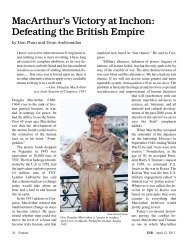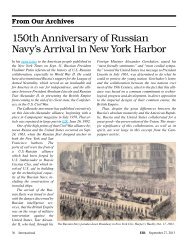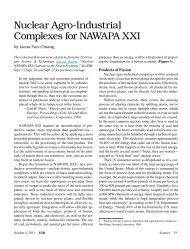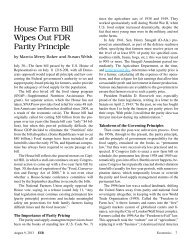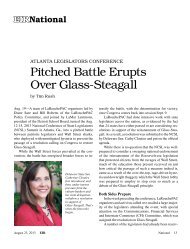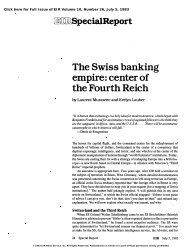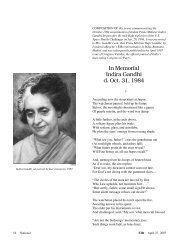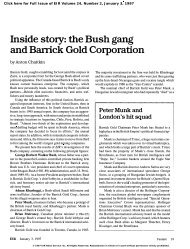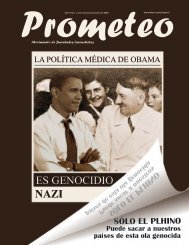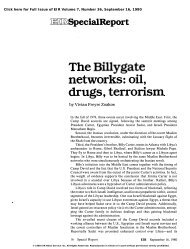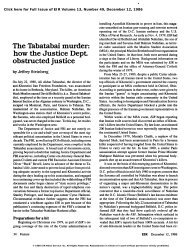View Full Issue - Executive Intelligence Review
View Full Issue - Executive Intelligence Review
View Full Issue - Executive Intelligence Review
Create successful ePaper yourself
Turn your PDF publications into a flip-book with our unique Google optimized e-Paper software.
Documentation<br />
Samudio's 'Report to<br />
the National Congress'<br />
A memorandum on the state of public order in Colombia,<br />
submitted by Defense Minister Rafael Samudio Molina to the<br />
opening sessions of Congress July 20, 1988.<br />
Internal situation<br />
Criminal methods. The country, today as never before , is<br />
facing a generalized state of disturbance of internal order,<br />
which is significantly affecting all layers of Colombian so<br />
ciety. This phenomenon stems from three well-defined<br />
sources:<br />
a) Armed subversion, which undoubtedly poses the prin<br />
cipal threat not only to public security but to the very exis<br />
tence of the State, since its single and unchangeable objective<br />
is seizure of power by force of arms and terrorism, in order<br />
to install a Marxist-Leninist regime.<br />
b) The drug trade , which by its very nature , goes against<br />
the juridical , social, and economic-not to mention moral<br />
order of the country, with its initial alliances and later con<br />
flicts with armed subversion, has caused the most terrifying<br />
violence in extensive, populated, and rich zones of the coun<br />
try , and international discredit never before experienced .<br />
c) Common crime attacks the principal cities of the coun<br />
try , as a logical socio-economic consequence of the great<br />
belts of misery that surround them, and because of the con<br />
stant emigration from country to city, due in part to the<br />
violence and social insecurity that scourges the country .<br />
Armed subversion. . . . This criminal activity has shown a<br />
special capacity to expand in the shadow of the most varied<br />
democratic measures intended to achieve peace and tranquil<br />
ity throughout the national territory . Subversion acts in the<br />
political, economic, education, labor, and armed arenas, with<br />
goals that are both well-defined and broadly known to nation<br />
al opinion . . . .<br />
Evolution. During the period covered by this report, and<br />
despite the government's efforts, armed subversion has con<br />
tinued to evolve and grow; in some cases, it has substantially<br />
modified its strategies, as in the case of the ELN [National<br />
Liberation Army] , a group which has taken a terrorist ap-<br />
ElK August 5, 1988<br />
proach to the oil exploitation and exploration activities in the<br />
country, at the same time assimilating the proven techniques<br />
of the FARC [Revolutionary Armed Forces of Colombia] ,<br />
organizing and executing peasant marches that affect the<br />
public order, especially in the northeastern region of the<br />
country.<br />
On the other hand, the FARC continues to constitute the<br />
principal threat; despite its apparent compliance with the<br />
cease-fire, and in addition to having persistence in keeping<br />
constant pressure on centers of civilian poulation by means<br />
of blackmail, kidnaping, and extortion, it has strengthened<br />
its military apparatus, having 39 "fronts" today , when in<br />
1984 it did not have even 30 . . . .<br />
Drug trafficking<br />
Drug-trafficking situation. The operations carried out in<br />
recent months, as well as intelligence efforts in rural areas ,<br />
have exposed the close links between the drug-trafficking<br />
mafi;lS and armed subversion, with the intention of creating<br />
"independent" regions, where the law is inapplicable and<br />
where they [mafiosi and subversives] are the only authority,<br />
turning these zones into bases of their illicit operations.<br />
The actions of different [trafficking] bands, their com<br />
petition to stay on top in specific areas of the international<br />
drug market, and the terrorism that they permanently exercise<br />
against authorities and citizenry alike, create special condi<br />
tions of violence where selective assassinations and massa<br />
cres are a daily occurrence. . . .<br />
Balance or operations. Despite the power of the so-called<br />
"cartels," the fight against the drug trade has shown a positive<br />
balance during this period; important cocaine-producing<br />
complexes in the departments of Antioquia, Boyaca, Caque<br />
ta, Cauca, and Valle have been deactivated; a significant<br />
number of processors and traffickers have been captured and<br />
delivered to the proper authorities; the systems of security<br />
and infrastructure used by the mafia in their criminal activities<br />
and in reprisals against rivals and public,officials have been<br />
uncovered, and it has become clear to all of society the<br />
ominous influence these merchants of death have exercised<br />
and want to strengthen in all areas of economic and merely<br />
social action. [The traffickers] have found their principal<br />
collaborator and accomplice in the unprotected mass of the<br />
population, desirous of improving its economic situation and<br />
of satisifying its minimal needs in the shortest time and with<br />
the greatest ease.<br />
Their force lies in their capacity to employ unlimited<br />
terror, through the recruitment of young assassins capable of<br />
taking the life of any citizen, no matter that other innocents<br />
may get in their way, for a sum of money. In view of these<br />
facts , authorities at every level are combining efforts in search<br />
of genuine integration both among themselves and with the<br />
community , to achieve greater efficiency in the fight against<br />
this plague. . . .<br />
International 43




